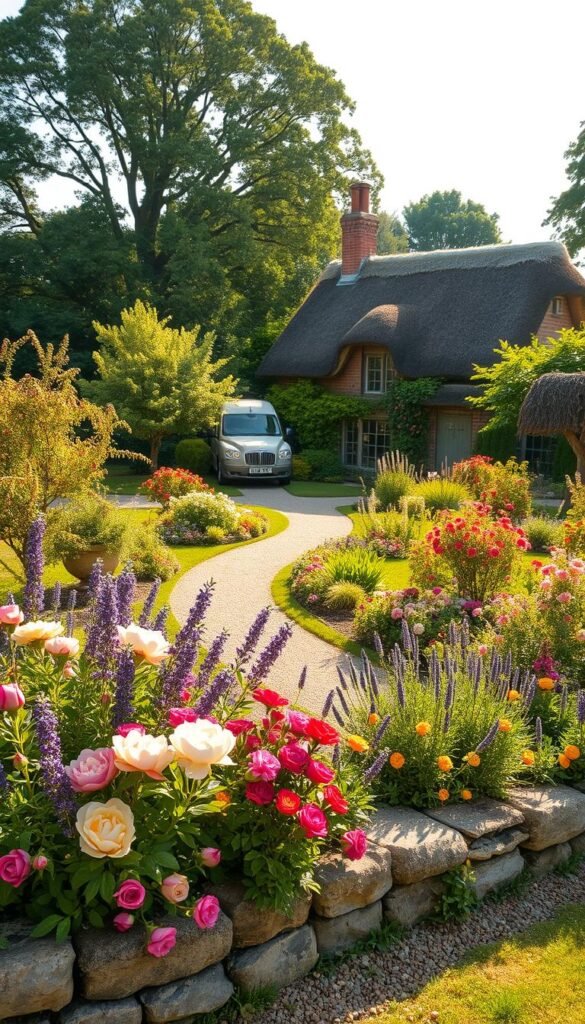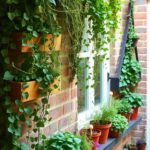Imagine stepping into a space where vibrant blooms mingle with fragrant herbs, and fruit trees whisper stories of centuries past. This charming style began in 16th-century rural plots, blending practicality with natural beauty. Families grew vegetables, medicinal plants, and flowers side by side, creating spaces that nourished both body and soul.
Today, this approach offers more than just visual appeal. By mixing ornamental plants with edible varieties, you’ll craft a living tapestry that feels wild yet intentional. The magic lies in balancing abundant growth with subtle structure—think climbing roses framing vegetable beds or lavender bordering berry bushes.
Want to add a touch of whimsy? Explore the cottagecore aesthetic for ideas on blending nostalgic charm with modern functionality. Your outdoor area can become a sanctuary where morning sunlight filters through apple blossoms and evening breezes carry the scent of thyme.
While these spaces appear effortless, they thrive on thoughtful planning. Focus on layering heights, textures, and bloom times to maintain interest year-round. With 60% decorative plants and 40% edibles, you’ll enjoy fresh salads and stunning bouquets from the same plot.
Ready to transform your yard? Start by embracing nature’s imperfections—let hollyhocks lean casually, allow mint to spill onto pathways, and celebrate the joyful chaos that makes this style timeless.
Embracing the Timeless Charm of Cottage Gardens
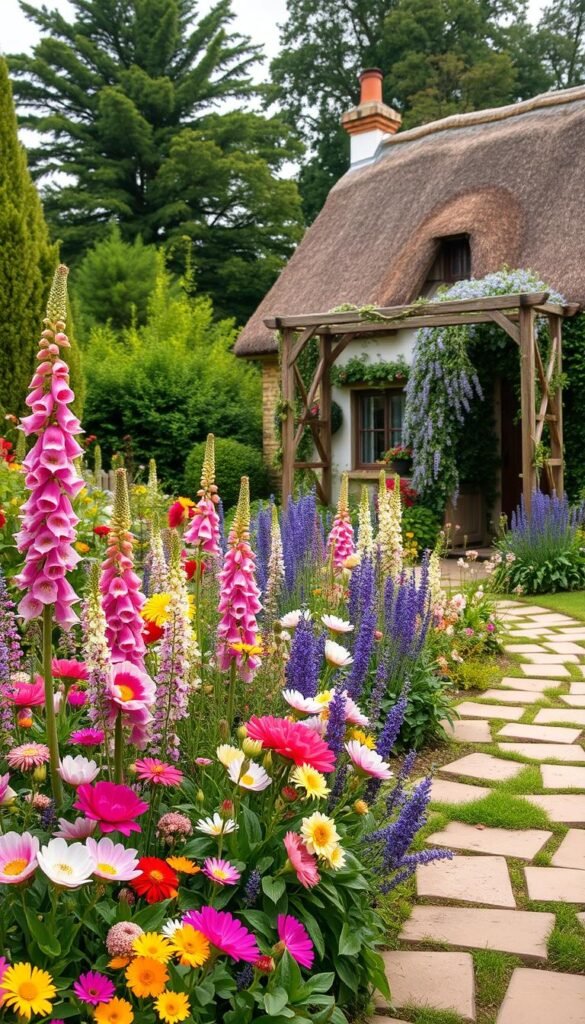
The roots of these spaces stretch back to a time when every plant had a purpose. Families once grew food, medicine, and beauty side by side, blending survival with artistry. What began as necessity evolved into a celebration of life’s simple joys—a legacy you can carry forward today.
Discovering the History and Romance
Centuries ago, rural households relied on their plots for everything from soups to salves. This practical foundation birthed spaces where roses tangled with rosemary, and fruit trees shaded healing herbs. Over time, these working areas became beloved for their unexpected beauty—proof that function and delight grow best together.
Understanding the Informal, Free-Flowing Aesthetic
True charm lies in the balance between wildness and intention. Curved gravel paths guide exploration, while arches draped in clematis create natural frames. Let plants spill over edges—lavender brushing walkways, hollyhocks leaning toward sunlight. This approach thrives when you mix self-seeding blooms with edible greens, ensuring lively textures from spring through frost.
For modern twists, consider layering heights and hues to mimic nature’s randomness. The magic? Structured elements hide in plain sight—raised beds organize chaos, while repeating colors unite the scene. Your space will feel both effortless and deeply personal, just like the gardens that inspired it.
English Cottage Garden Design Layout: How to Recreate This Classic Look
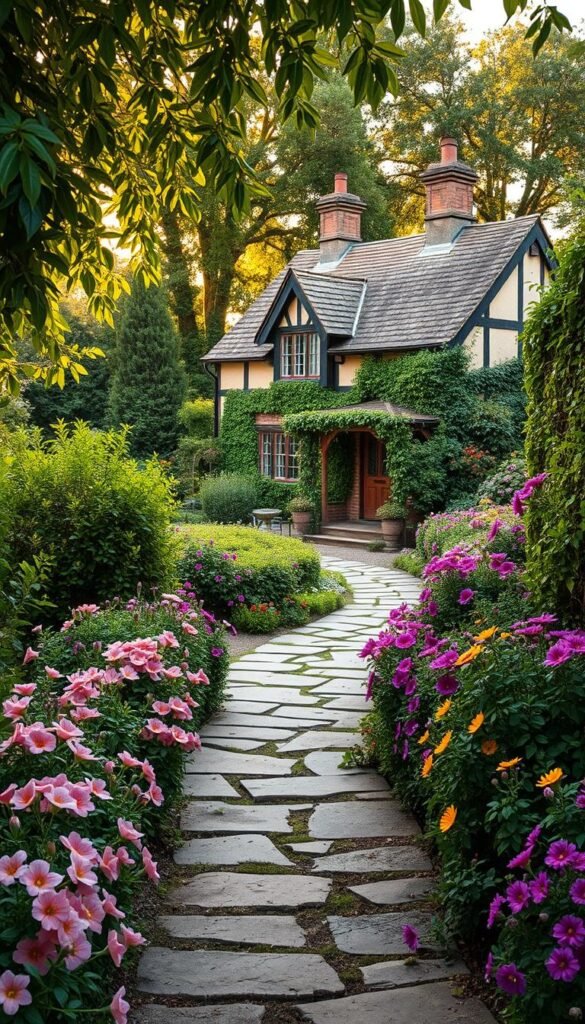
Crafting a timeless outdoor space starts with foundational elements that blend form and function. Let’s explore how to shape your plot using smart structural choices and harmonious plant combinations.
Key Structural Elements and Pathways
Curved walkways made of weathered brick or crushed gravel invite exploration while preventing rigid lines. These paths become living borders as thyme creeps between stones and nasturtiums tumble over edges.
Arched trellises draped in climbing roses add vertical layers without sacrificing ground space. Pair them with sweet peas or runner beans for edible elegance. Strategic screens like lattice panels hide compost bins while supporting flowering vines.
Balancing Vegetables, Herbs, and Flowers
Mix practical and pretty by planting rainbow chard behind drifts of cosmos. Basil thrives when nestled between zinnias, while cherry tomatoes climb obelisks surrounded by marigolds. This approach yields fresh ingredients and endless bouquets.
Group plants in irregular clusters for that lived-in charm. Let parsley form feathery mounds beside snapdragons, and allow mint to spill onto stepping stones. Repeat colors across beds to unify the space—purple sage echoing lavender blooms creates visual harmony.
Planning Your Garden Space for a Whimsical Look
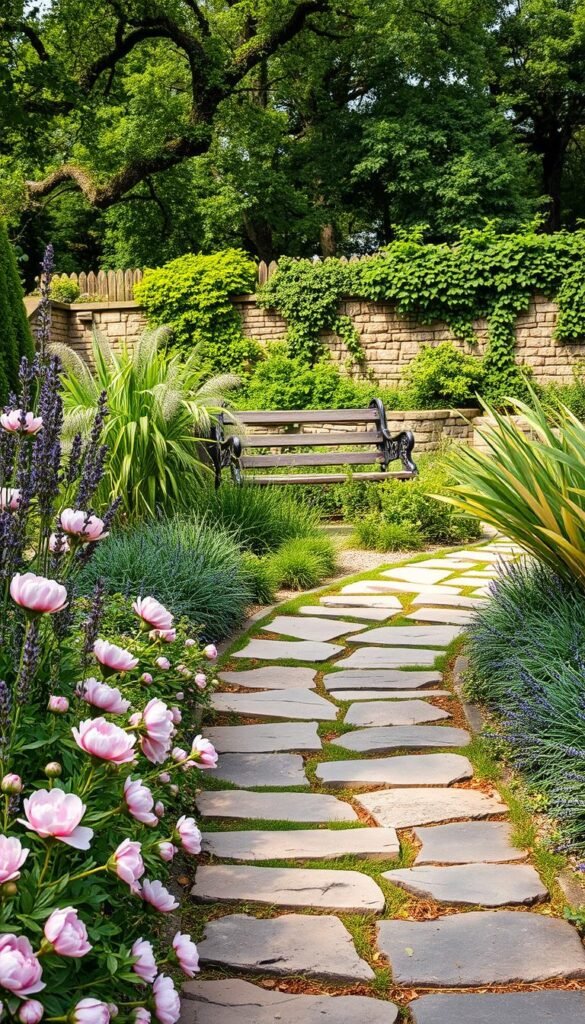
Transform your outdoor area into a living storybook by first mapping its flow. Begin with pencil and paper, sketching swooping lines that mimic nature’s imperfections. These organic curves become your guide for creating hidden nooks and visual surprises.
Sketching Curved Pathways and Natural Edges
Draw winding routes using materials like pea gravel or reclaimed bricks. Allow these paths to hug existing features—a weathered bench, a birdbath, or your home’s foundation. Soften edges by letting creeping thyme or chamomile spill onto walkways, creating that coveted “lived-in” charm.
Designing from Smallest to Tallest Plantings
Build vertical interest using this simple formula:
- 6-12″ plants (thyme, violas) along path borders
- 2-3′ varieties (lavender, coreopsis) in middle zones
- 5-6′ showstoppers (hollyhocks, sunflowers) at the rear
This tiered approach ensures every plant gets noticed. Leave 12-18″ between clusters for growth while maintaining fullness. For creative twists, tuck edible nasturtiums among roses or let pole beans climb through flowering vines.
Remember: Your planting choices should balance form and function. Dense groupings feel magical but need air circulation—space taller specimens to cast dappled shade on heat-sensitive herbs below. With thoughtful layering, you’ll craft a space that delights the senses while thriving season after season.
Selecting Plants and Flowers for Vibrant Garden Borders
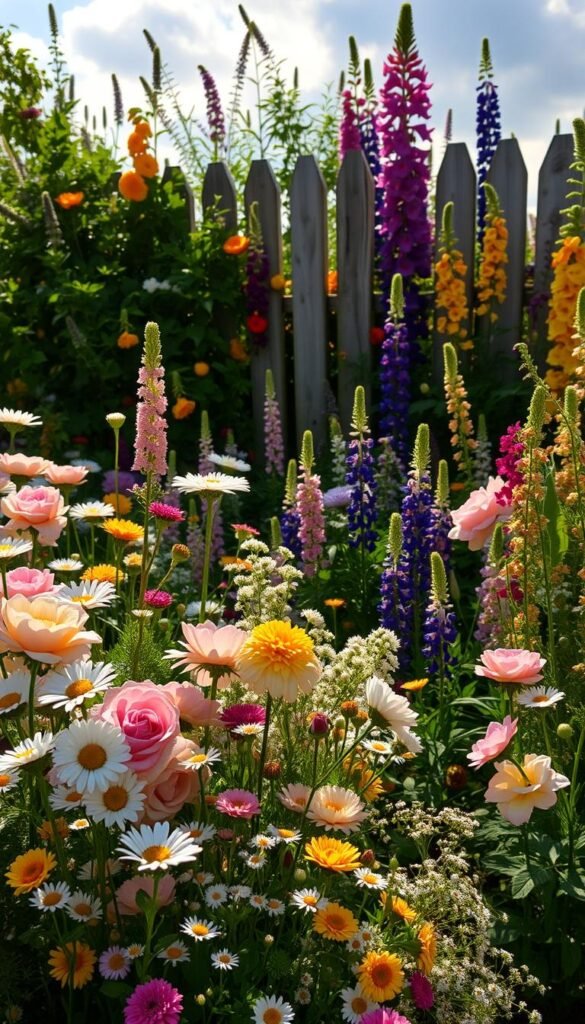
The secret to lush, ever-changing borders lies in pairing reliable performers with spontaneous surprises. Aim for 70% long-living varieties that return yearly, complemented by 30% temporary fillers that add bursts of color.
Mixing Perennials, Annuals, and Essentials
Roses and lavender form the backbone of authentic displays, offering structure and fragrance. Add hollyhocks for vertical drama—their drought-resistant nature makes them perfect for sunny edges. Intersperse these with self-seeding annuals like cosmos, which pop up in new spots each spring.
Consider this winning trio:
| Role | Perennials | Annuals |
|---|---|---|
| Early Color | Peonies (May-June) | Sweet peas (June frost) |
| Summer Stars | Delphiniums | Snapdragons |
| Late Show | Astilbe | Zinnias |
Traditional Blooms with Modern Resilience
Foxgloves and lupines bring old-world charm but opt for disease-resistant varieties like Digitalis ‘Camelot’. Yarrow and bee balm thrive in poor soil while attracting pollinators. For texture, mix feathery columbine with spiky iris leaves.
Remember: Let plants mingle naturally. Allow geum to cascade over walkways and let nicotiana perfume evening strolls. This layered approach ensures something always catches the eye—from spring’s first poppy to autumn’s golden rudbeckia.
Integrating Structural Features and Garden Paths
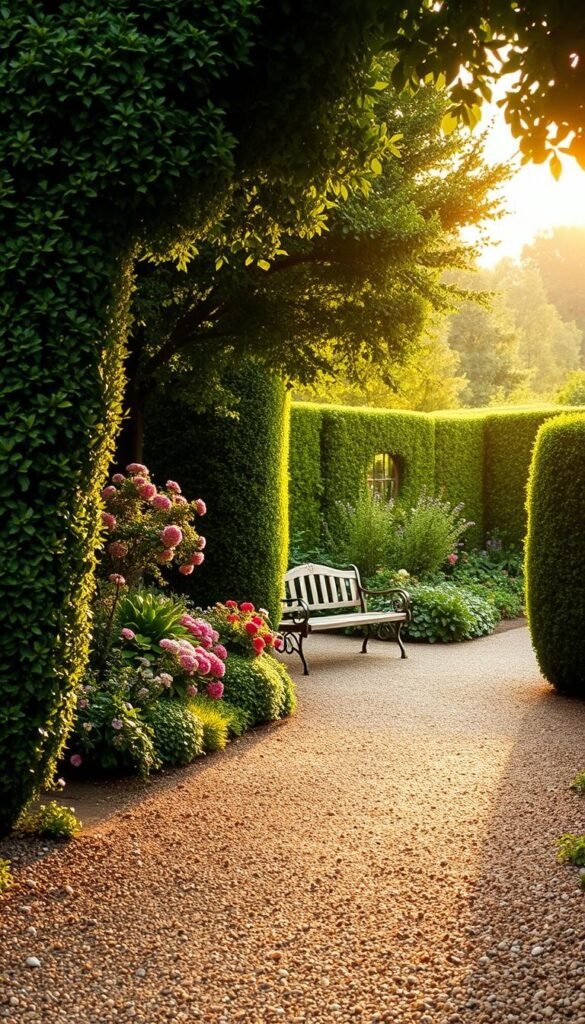
The bones of a captivating outdoor space lie in its structural elements. Thoughtful hardscaping guides movement while framing your plantings like a living painting.
Choosing Materials for Authentic Low Hedges and Walkways
Low hedges define spaces without blocking views. While boxwood remains popular, modern alternatives like inkberry holly offer similar structure with better disease resistance. Tightly planted lavender or catmint creates fragrant borders that buzz with pollinators.
| Material | Best For | Height | Key Benefit |
|---|---|---|---|
| Boxwood | Formal edges | 12-24″ | Year-round structure |
| Inkberry Holly | Wet areas | 18-36″ | Berry production |
| Lavender | Sunny borders | 12-18″ | Aromatic foliage |
| Catmint | Soft edges | 9-12″ | Long bloom time |
Path materials should whisper “step this way” naturally. Crushed gravel crackles underfoot, while reclaimed bricks develop mossy charm. For continuity, match walkway colors to your home’s exterior.
Let plants blur boundaries between beds and paths. Allow creeping thyme to invade stone gaps and let roses arch over gravel. This softness invites exploration while hiding wear patterns.
Strategic hedges do triple duty—they frame flower displays, shelter tender plants from wind, and create intimate seating nooks. Position them to guide eyes toward focal points like benches or birdbaths.
When planning routes, make paths wide enough for wheelbarrows but narrow enough to feel adventurous. Curves should reveal surprises: maybe a cluster of foxgloves here, a blend of old and new elements there. Your journey through the space becomes part of its magic.
Creating a Functional and Fragrant Kitchen Garden
Your kitchen garden becomes a living pantry when you blend practicality with beauty. Start by mixing herbs, vegetables, and flowers in patterns that delight the eye while filling your basket. This approach turns every harvest into both a chore and a treasure hunt.
Planting Culinary, Medicinal, and Cosmetic Herbs
Rosemary and thyme anchor beds with evergreen structure, while holy basil offers leaves for tea and natural remedies. Lemon balm’s citrusy leaves work in salads or homemade balms. Let marshmallow’s pink blooms brighten borders—its roots have traditional uses too.
Maximizing Space with Edible and Ornamental Choices
Train nasturtiums up obelisks—their edible flowers hide vertical supports. Tuck cherry tomatoes between marigolds to deter pests while creating snack stations. Lovage’s tall stems add drama behind low-growing oregano, proving every inch counts.
Your fragrant corner thrives when you pair lavender with sage—both repel deer while attracting bees. Let children pluck gherkins straight from the vine, fostering lifelong love for growing food. With smart plant choices, your kitchen plot becomes equal parts apothecary, pantry, and poetry.

